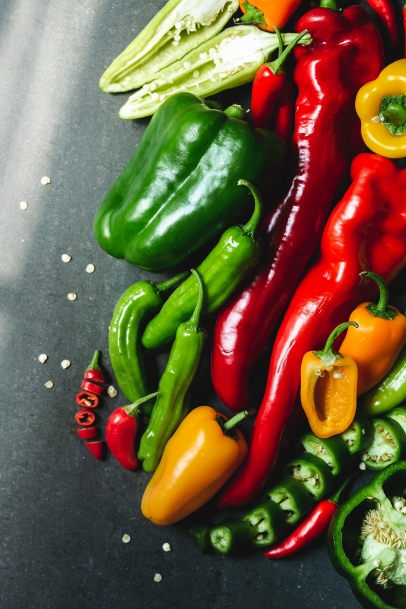In-season Ingredient: Peppers
Botanically a fruit but used as a vegetable in the culinary world, peppers are an integral part of traditional cuisines around the world. There are an estimated 50,000 varieties of peppers in existence today, and they have been cultivated for more than 6,000 years, making them one of the oldest cultivated crops in the Americas. Some, like bell peppers, do not contain any capsaicin (the active component giving peppers their heat), while others can pack a wallop. The Carolina Reaper holds the record for the world’s hottest pepper: It is 200 times hotter than a jalapeño. Hot peppers are often referred to as chilis, chillis (British spelling) or chiles (Spanish).
Peppers can be consumed raw, stuffed, stewed, smoked, roasted, pickled, dried and ground; the method of preparation alters the flavor of each variety in magical ways. For example, fully ripened jalapeños can be smoked and dried to create chipotle peppers; ripe poblano peppers are dried to create ancho chiles. The results are sweeter, more robust and richer than a young pepper straight from the vine.
I haven’t developed a tolerance for the hotter peppers, not yet at least. My childhood garden was full of sweet bell peppers, ready for stuffing or slicing. But as I’ve grown and experienced more cuisines from around the world, I’ve learned to appreciate and love the flavors of chipotle peppers with tomatoes or hot green chilis with curries.
We’ve created recipes that celebrate sweet and spicy peppers, allowing you to experiment with the different varieties in season this time of year.
Selecting:
In most cases, peppers will be green once they begin sprouting on a plant. Pick peppers when they have developed the correct color and size for the variety you are growing. From the market, select peppers that are firm to the touch with no visible wrinkles or mold. When selecting milder peppers, search for varieties such as bell, shishito, pimiento, piquillo, cubanelle, banana, poblano or Anaheim. When selecting hotter peppers, search for varieties such as jalapeño, serrano, habanero, cayenne or Thai chili.
Storing:
Store peppers in the crisper drawer of your refrigerator and consume within 1 to 2 weeks. Peppers can be chopped and stored in the freezer to be used within 12 months. It’s best to use frozen peppers in cooked dishes, since they will lose their crispness in the freezer. Alternatively, peppers can be dehydrated and stored at room temperature for 1 to 2 years. Dried peppers can be left whole or ground into flakes or a powder. You can also preserve peak pepper flavors by pickling them or making pepper jam or a homemade hot sauce.
Pairing:
Alliums, arugula, asparagus, avocados, basil, bay leaves, beans, beef, beer, beets, berries, broccoli, butter, cabbage, carrots, cauliflower, celery, cheese, chicken, cilantro, cinnamon, coconut, corn, cucumbers, dill, eggs, fennel, fish, ginger, honey, kale, lemons, lentils, lettuce, limes, liquor, mango, milk, mint, mushrooms, mustard, nuts, olives, oranges, oregano, parsley, peas, pork, potatoes, radishes, rice, rosemary, sage, sesame, soy, spinach, squash, sweet potatoes, Swiss chard, tarragon, thyme, tomatoes, turkey, vinegar, wheat, wine.
Ashley Swartzendruber i s Edible Michiana’s recipe editor, stylist and photographer based in Goshen, Indiana. She can be found cooking, eating and photographing local food in her home or exploring Michiana with her family. You can find more of her photos, styling and motherhood musings on her Instagram @mywildhaven.







